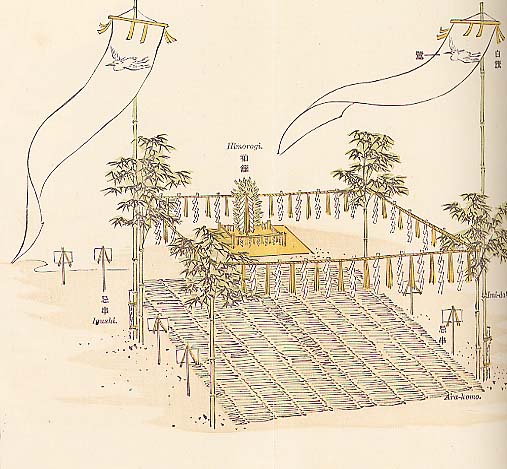- --creating sacred space
- --invoking the deity
- --celebrating
- --prayer
- --sacrifice
- --sendind off the deity
- --celebrating

Shimenawa
Rope made by twisting together strands of rice straw. Used to mark sacred space, to keep inpurity out. Should be twisted, so that the direction of the twist is to the left, the pure side.
Sakaki
Cleyera japonica An evergreen tree common in Japan, Korea, China. Evergreen trees are seen as a place were Kami dwell, this led to the use of sakaki branches in Shinto ritual. If no sakaki is available, a smaller variety , Hisakaki is used.

Purification
Purification is a key element of Shinto. Misogi is purification after contact with inpure elements (kegare), death or disease as an example.
Harae is restoration of order,life-force after wrongdoing.
Kegare is ritual inpurity, some examples: human blood, everything dead, including animals. Killing or wounding of birds and beasts, cooking them. Actions that disturb human society, incest, beastiality, natural disasters
You can feel it as tiredness, strange body odor, skin problems,etc.
Tsumi-anything that hinders growth and development of life-force or causes its degeneration.
Tsumi may come upon one by powers outside induvidual control. Therefore it is one's responsibility to maintain purity by participating in the gods activity of regenerating and creating the world, by atoning for wrongs and caused inpurity's. By purifying ones body and soul, living in harmony with natural and human order.
Purification is essential before ceremonies. Priests undergo cleansing rites before festivals and community rites. Those rites are called harae. They may consist in a period of seclusion and fasting,eating only food prepared with pure ingriedients, cooked with holy fire, staying in shrine buildings, bathing,praying, abstaining from sex and anything inpure, for example: no meat, no contact with death or disease, disfigured persons, menstruating women. This period may last 30 days. Sansai are purification rites done on days before and after festivals, chisai on the day of a festival.
Purification rites also include: -Misogi -weaving harae-gushi over the to be purified, -recitation of harae kotoba, a type of Norito with powers to purify, -presentation of offerings to Kami

Sacrifices
Sacrifices in Shinto are mainly:
- -rice
- -sake
- -fish
- -vegetables
As part of rites, participants take part in a communion ( naorai ) in which the food offered to the Kami is consumed.
Tama
Tama is life-force in any living thing. Each Kami has tama, which may appear gentle (nigimitama) or wild (aramitama). The tama of a Kami is called in ritual to listen to the praise and requests of the community. It is offered food, praised again and sent back. During the rite the tama of the Kami is present in a sacred tree, stone, mirror, branch, sword etc. Tama is inexhaustible.
Human beings also contain tama. After death this tama leaves the body and becomes an ancestral spirit. It will merge with Kami after the 33rd aniversary of the death if proper rites are carried out. In those cases where there are no descendants to carry out those rites, the spirit may become ghostlike and haunt the living.Or be reborn. That may also happen if a soul has unfinished business, which can only be resolved by returning to this plane.
It is believed that one can really give away one's life to another person, creature or even to a tree, by the favor of the Gods. And thus to transfer one's life is expressed by the term: migawari ni tatsu - to act as a substitute.
Some say that there are a number of souls.See Hearn 1894 Glimpses of unfamiliar Japan. ..."Some have five,some six, some seven, some eight Souls. But no one is by the gods permitted to have more Souls than nine."... ..."And it is better to have many souls than a few?" "It is better."... ..."The gods alone fix the number of Souls for each of us.To the worthy are given many; to the unworthy few." "Not from the parents, then do the Souls descend?" "Nay! Most ancient the Souls are: innumerable the years of them."...
